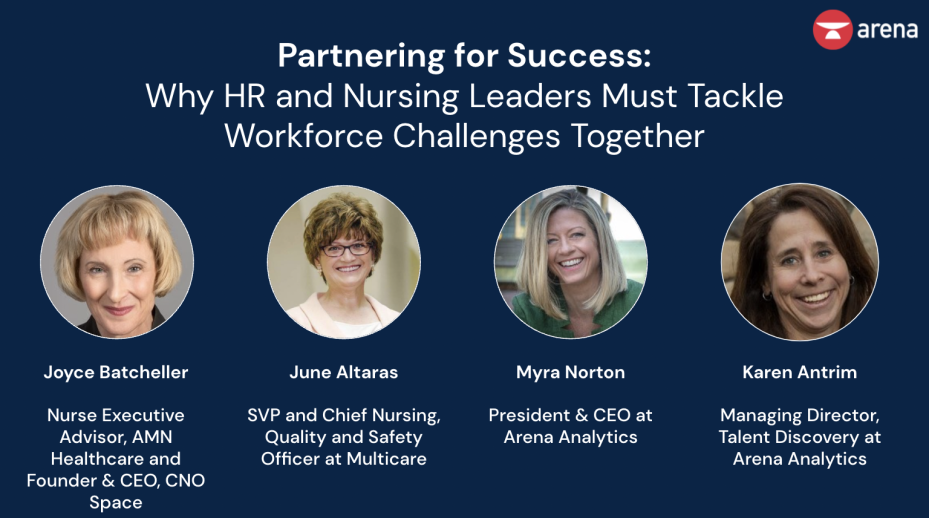We recently hosted a webinar titled Partnering for Success: Why HR and Nursing Leaders Must Tackle Workforce Challenges Together featuring:
Joyce Batcheller (Nurse Executive Advisor, AMN Healthcare and Founder & CEO, CNO Space)
June Altaras (EVP, Chief Quality, Safety & Nursing Officer, Multicare)
Karen Antrim inkedin.com/in/karenantrim/(Managing Director of Talent Discovery, Arena Analytics)
Myra Norton (President & CEO, Arena Analytics).
When Altaras joined Multicare, she recognized that the talent acquisition processes in place were fractured, due partly to a disjointed relationship between HR and nursing leadership. Altaras understood that in order to stay competitive in this cutthroat labor market, her team needed to have tight processes in place.
While she admits there is still work to be done, improving communication and adopting new technologies has helped Multicare increase retention, decrease time-to-hire, and improve culture across the organization.
1. Audit Processes & Set Metrics
A major hurdle faced by Multicare was a lack of clear metrics and processes. To start the process, both teams got together to look at the data in their processes, including:
How long it took to get to candidates after they expressed interest
How long it took to get candidates to their first screening
Number of applicants per job
Application abandonment rate
How many candidates dropped out of the process
Antrim, a sourcing and recruitment expert, put it this way:
“Time to fill is everyone’s responsibility. Talent acquisition is not just a department, it’s a process everyone in the hiring process is responsible for.”
2. Rebuild Workflows
Once Altaras and her team understood the lay of the land, they were able to take steps to improve it.
“It requires a lot of partnership between HR and nursing to really smooth processes so you can compete and get ahead in the talent war,” said Altaras.
One typically complicated handoff between HR and Nursing is when a candidate is passed forward for a screening interview. If a candidate sits on the nursing manager’s plate for too long before scheduling, they may exit the process.
A few ways you can speed up the process include:
Allowing candidates to self schedule on a hiring manager’s calendar
Allow managers to make contingent offers
Shorten the application itself
In this competitive landscape, “the fastest guy wins,” says Antrim. “RNs are being reached out to by travel, big bucks, all sorts of things are being dangled in front of them. We need to move fast.”
To assist with these ongoing processes, the HR and Nursing leadership teams at Multicare now meet regularly.
Nursing leaders have also asked that the HR team has stability within the recruiters with their nurse managers so they are able to develop a relationship. This way, the recruiter really knows the leader they’re hiring for, the culture of the team, and what it looks like within those teams.
3. Adopt Technology
One of the best ways to optimize your processes is by adopting technology.
Start by setting up automated emails to candidates to thank them for applying. Then, add a self-scheduling software to allow candidates to book time on hiring manager’s calendars.
Another powerful way to hire more efficiently and reduce turnover is to use predictive analytics. Multicare uses Arena Analytics to understand which candidates are most likely to succeed at their organization. At a glance, they see their list of incoming candidates and whether they are marked Likely, Neutral, or Unlikely to retain in that exact position.
“Those who are ranked Unlikely but we chose to hire anyway in the last year had 22% turnover. However, those that were ranked Likely to stay were at 9% turnover,” said Altaras.
Compare that to the industry average hospital turnover of 19.5%, and Multicare is clearly ahead of the curve.
“This partnership is invaluable to us,” said Altaras. “We face a lot of competition for nurses in our area. The predictive piece is really important.”
4. Consider Non-Traditional Talent Pools
All your efforts to improve processes and look at data won’t help the fact that there is a shortage of nurses nationwide – and there’s not much relief in sight.
Myra Norton suggests looking at nontraditional talent pools to fill your pipeline. “I recognize that you can’t move someone from hospitality to an ICU nurse overnight. But there are critical roles that are a stepping stone to nursing,” said Norton.
Consider those in food service at a restaurant, or working a customer service or retail job. “There’s no reason they can’t provide that same service in a hospital,” said Norton.
It may seem risky to approach nontraditional candidates, but this is where predictive analytics can help. Arena Analytics helps Multicare and other clients evaluate whether a client is predicted to retain, even if they don’t have a background in healthcare.
“We’ve had many people come in as untrained caregivers and are put on the path for CNA. These employees say, ‘I never thought about a career in nursing, but I like what I’m doing, this is meaningful to me.’ This can start building a bigger pipeline of folks that can fit into what the model of care evolves to be,” said Norton.
By attracting these candidates early in their career, investing in their training and schooling, hospitals can develop relationships with loyal employees who want to stay.
5. Put Culture First
While flashy bonuses and incentives may attract the attention of some nurses, Altaras believes that the intrinsic things are what will keep people to stay at the end of the day.
“Culture will win the day. If you create the right culture for people, where they feel empowered and safe, they won’t want to leave,” said Altaras.

![[object Object]](https://images.ctfassets.net/ucbt0bqomge5/76SmkW7YlHQZN9XNObm5dn/06de84ccc6cdfaba7e4632898631d605/Predictive-Technologies-to-Find-_-Hire-the-Best-Workers-DARK.png?w=352&h=240&q=100&fm=png)
![[object Object]](https://images.ctfassets.net/ucbt0bqomge5/2L6WESUpKZWMdhhsgHkvxg/fef3e7efa7e08a3f356e290ce0ce93aa/remove-systemic-obstacles-that-prevent-nurses-from-delivering-quality-care-RESIZED.png?w=352&h=240&q=100&fm=png)